Bowen Du
Co-Neighbor Encoding Schema: A Light-cost Structure Encoding Method for Dynamic Link Prediction
Jul 30, 2024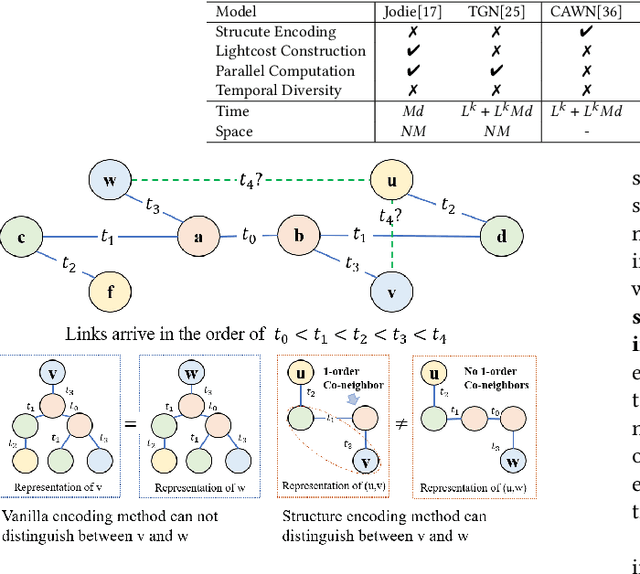
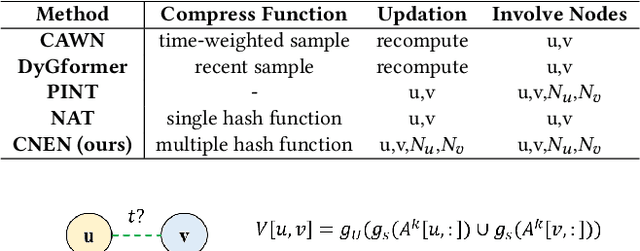
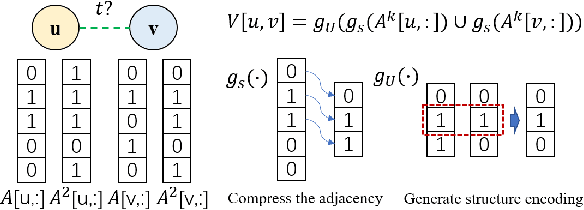
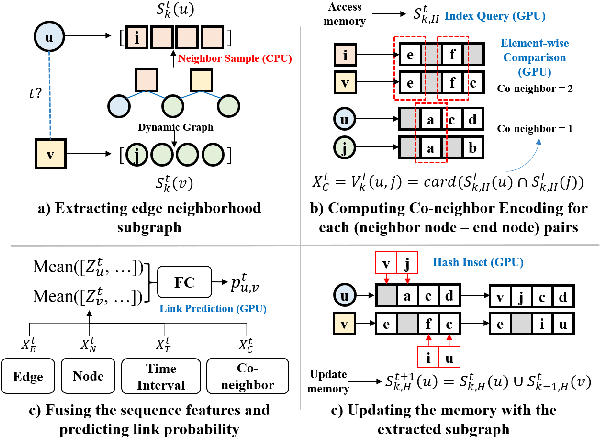
Abstract:Structure encoding has proven to be the key feature to distinguishing links in a graph. However, Structure encoding in the temporal graph keeps changing as the graph evolves, repeatedly computing such features can be time-consuming due to the high-order subgraph construction. We develop the Co-Neighbor Encoding Schema (CNES) to address this issue. Instead of recomputing the feature by the link, CNES stores information in the memory to avoid redundant calculations. Besides, unlike the existing memory-based dynamic graph learning method that stores node hidden states, we introduce a hashtable-based memory to compress the adjacency matrix for efficient structure feature construction and updating with vector computation in parallel. Furthermore, CNES introduces a Temporal-Diverse Memory to generate long-term and short-term structure encoding for neighbors with different structural information. A dynamic graph learning framework, Co-Neighbor Encoding Network (CNE-N), is proposed using the aforementioned techniques. Extensive experiments on thirteen public datasets verify the effectiveness and efficiency of the proposed method.
DyGKT: Dynamic Graph Learning for Knowledge Tracing
Jul 30, 2024



Abstract:Knowledge Tracing aims to assess student learning states by predicting their performance in answering questions. Different from the existing research which utilizes fixed-length learning sequence to obtain the student states and regards KT as a static problem, this work is motivated by three dynamical characteristics: 1) The scales of students answering records are constantly growing; 2) The semantics of time intervals between the records vary; 3) The relationships between students, questions and concepts are evolving. The three dynamical characteristics above contain the great potential to revolutionize the existing knowledge tracing methods. Along this line, we propose a Dynamic Graph-based Knowledge Tracing model, namely DyGKT. In particular, a continuous-time dynamic question-answering graph for knowledge tracing is constructed to deal with the infinitely growing answering behaviors, and it is worth mentioning that it is the first time dynamic graph learning technology is used in this field. Then, a dual time encoder is proposed to capture long-term and short-term semantics among the different time intervals. Finally, a multiset indicator is utilized to model the evolving relationships between students, questions, and concepts via the graph structural feature. Numerous experiments are conducted on five real-world datasets, and the results demonstrate the superiority of our model. All the used resources are publicly available at https://github.com/PengLinzhi/DyGKT.
Repeat-Aware Neighbor Sampling for Dynamic Graph Learning
May 24, 2024Abstract:Dynamic graph learning equips the edges with time attributes and allows multiple links between two nodes, which is a crucial technology for understanding evolving data scenarios like traffic prediction and recommendation systems. Existing works obtain the evolving patterns mainly depending on the most recent neighbor sequences. However, we argue that whether two nodes will have interaction with each other in the future is highly correlated with the same interaction that happened in the past. Only considering the recent neighbors overlooks the phenomenon of repeat behavior and fails to accurately capture the temporal evolution of interactions. To fill this gap, this paper presents RepeatMixer, which considers evolving patterns of first and high-order repeat behavior in the neighbor sampling strategy and temporal information learning. Firstly, we define the first-order repeat-aware nodes of the source node as the destination nodes that have interacted historically and extend this concept to high orders as nodes in the destination node's high-order neighbors. Then, we extract neighbors of the source node that interacted before the appearance of repeat-aware nodes with a slide window strategy as its neighbor sequence. Next, we leverage both the first and high-order neighbor sequences of source and destination nodes to learn temporal patterns of interactions via an MLP-based encoder. Furthermore, considering the varying temporal patterns on different orders, we introduce a time-aware aggregation mechanism that adaptively aggregates the temporal representations from different orders based on the significance of their interaction time sequences. Experimental results demonstrate the superiority of RepeatMixer over state-of-the-art models in link prediction tasks, underscoring the effectiveness of the proposed repeat-aware neighbor sampling strategy.
Pretraining Language Models with Text-Attributed Heterogeneous Graphs
Oct 23, 2023Abstract:In many real-world scenarios (e.g., academic networks, social platforms), different types of entities are not only associated with texts but also connected by various relationships, which can be abstracted as Text-Attributed Heterogeneous Graphs (TAHGs). Current pretraining tasks for Language Models (LMs) primarily focus on separately learning the textual information of each entity and overlook the crucial aspect of capturing topological connections among entities in TAHGs. In this paper, we present a new pretraining framework for LMs that explicitly considers the topological and heterogeneous information in TAHGs. Firstly, we define a context graph as neighborhoods of a target node within specific orders and propose a topology-aware pretraining task to predict nodes involved in the context graph by jointly optimizing an LM and an auxiliary heterogeneous graph neural network. Secondly, based on the observation that some nodes are text-rich while others have little text, we devise a text augmentation strategy to enrich textless nodes with their neighbors' texts for handling the imbalance issue. We conduct link prediction and node classification tasks on three datasets from various domains. Experimental results demonstrate the superiority of our approach over existing methods and the rationality of each design. Our code is available at https://github.com/Hope-Rita/THLM.
Adaptive Taxonomy Learning and Historical Patterns Modelling for Patent Classification
Aug 10, 2023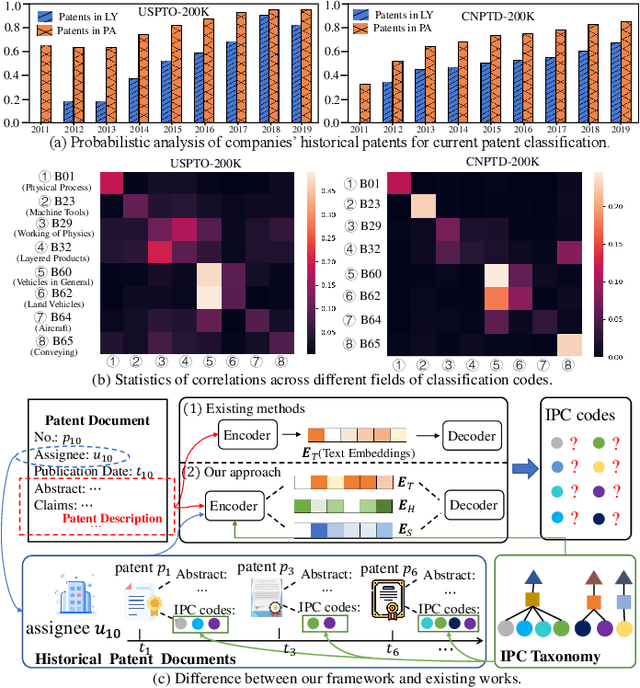

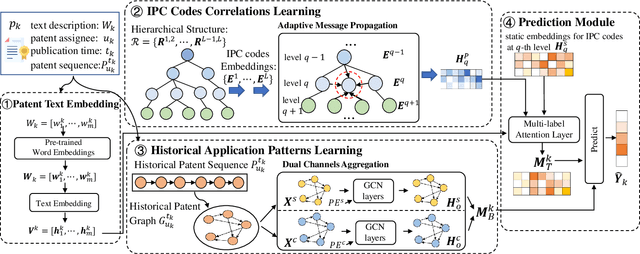
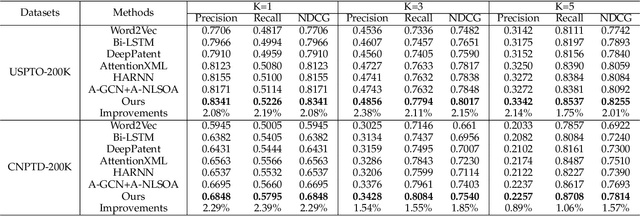
Abstract:Patent classification aims to assign multiple International Patent Classification (IPC) codes to a given patent. Recent methods for automatically classifying patents mainly focus on analyzing the text descriptions of patents. However, apart from the texts, each patent is also associated with some assignees, and the knowledge of their applied patents is often valuable for classification. Furthermore, the hierarchical taxonomy formulated by the IPC system provides important contextual information and enables models to leverage the correlations between IPC codes for more accurate classification. However, existing methods fail to incorporate the above aspects. In this paper, we propose an integrated framework that comprehensively considers the information on patents for patent classification. To be specific, we first present an IPC codes correlations learning module to derive their semantic representations via adaptively passing and aggregating messages within the same level and across different levels along the hierarchical taxonomy. Moreover, we design a historical application patterns learning component to incorporate the corresponding assignee's previous patents by a dual channel aggregation mechanism. Finally, we combine the contextual information of patent texts that contains the semantics of IPC codes, and assignees' sequential preferences to make predictions. Experiments on real-world datasets demonstrate the superiority of our approach over the existing methods. Besides, we present the model's ability to capture the temporal patterns of assignees and the semantic dependencies among IPC codes.
Event-based Dynamic Graph Representation Learning for Patent Application Trend Prediction
Aug 04, 2023Abstract:Accurate prediction of what types of patents that companies will apply for in the next period of time can figure out their development strategies and help them discover potential partners or competitors in advance. Although important, this problem has been rarely studied in previous research due to the challenges in modelling companies' continuously evolving preferences and capturing the semantic correlations of classification codes. To fill in this gap, we propose an event-based dynamic graph learning framework for patent application trend prediction. In particular, our method is founded on the memorable representations of both companies and patent classification codes. When a new patent is observed, the representations of the related companies and classification codes are updated according to the historical memories and the currently encoded messages. Moreover, a hierarchical message passing mechanism is provided to capture the semantic proximities of patent classification codes by updating their representations along the hierarchical taxonomy. Finally, the patent application trend is predicted by aggregating the representations of the target company and classification codes from static, dynamic, and hierarchical perspectives. Experiments on real-world data demonstrate the effectiveness of our approach under various experimental conditions, and also reveal the abilities of our method in learning semantics of classification codes and tracking technology developing trajectories of companies.
Learning Joint 2D & 3D Diffusion Models for Complete Molecule Generation
May 21, 2023Abstract:Designing new molecules is essential for drug discovery and material science. Recently, deep generative models that aim to model molecule distribution have made promising progress in narrowing down the chemical research space and generating high-fidelity molecules. However, current generative models only focus on modeling either 2D bonding graphs or 3D geometries, which are two complementary descriptors for molecules. The lack of ability to jointly model both limits the improvement of generation quality and further downstream applications. In this paper, we propose a new joint 2D and 3D diffusion model (JODO) that generates complete molecules with atom types, formal charges, bond information, and 3D coordinates. To capture the correlation between molecular graphs and geometries in the diffusion process, we develop a Diffusion Graph Transformer to parameterize the data prediction model that recovers the original data from noisy data. The Diffusion Graph Transformer interacts node and edge representations based on our relational attention mechanism, while simultaneously propagating and updating scalar features and geometric vectors. Our model can also be extended for inverse molecular design targeting single or multiple quantum properties. In our comprehensive evaluation pipeline for unconditional joint generation, the results of the experiment show that JODO remarkably outperforms the baselines on the QM9 and GEOM-Drugs datasets. Furthermore, our model excels in few-step fast sampling, as well as in inverse molecule design and molecular graph generation. Our code is provided in https://github.com/GRAPH-0/JODO.
Towards Better Dynamic Graph Learning: New Architecture and Unified Library
Mar 23, 2023



Abstract:We propose DyGFormer, a new Transformer-based architecture for dynamic graph learning that solely learns from the sequences of nodes' historical first-hop interactions. DyGFormer incorporates two distinct designs: a neighbor co-occurrence encoding scheme that explores the correlations of the source node and destination node based on their sequences; a patching technique that divides each sequence into multiple patches and feeds them to Transformer, allowing the model to effectively and efficiently benefit from longer histories. We also introduce DyGLib, a unified library with standard training pipelines, extensible coding interfaces, and comprehensive evaluating protocols to promote reproducible, scalable, and credible dynamic graph learning research. By performing extensive experiments on thirteen datasets from various domains for transductive/inductive dynamic link prediction and dynamic node classification tasks, we observe that: DyGFormer achieves state-of-the-art performance on most of the datasets, demonstrating the effectiveness of capturing nodes' correlations and long-term temporal dependencies; the results of baselines vary across different datasets and some findings are inconsistent with previous reports, which may be caused by their diverse pipelines and problematic implementations. We hope our work can provide new insights and facilitate the development of the dynamic graph learning field. All the resources including datasets, data loaders, algorithms, and executing scripts are publicly available at https://github.com/yule-BUAA/DyGLib.
PriSTI: A Conditional Diffusion Framework for Spatiotemporal Imputation
Feb 20, 2023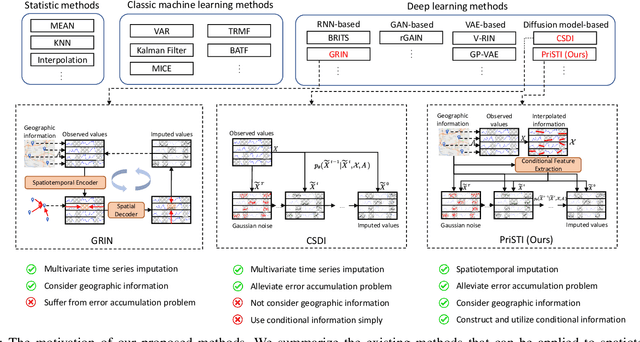
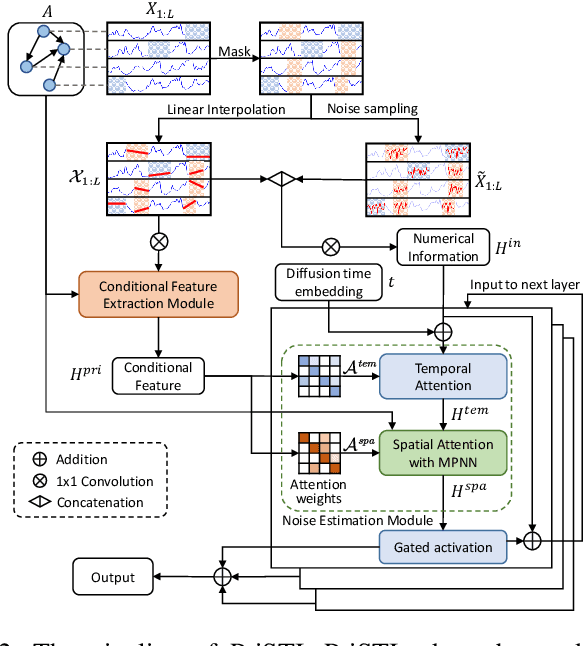
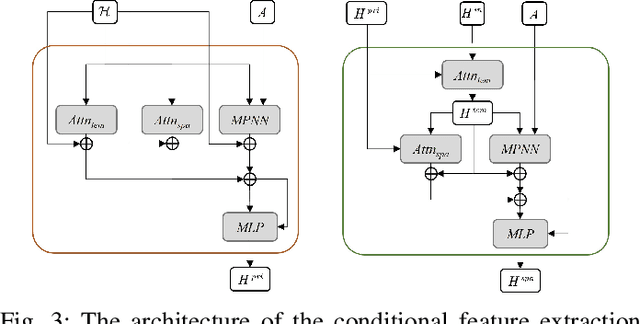
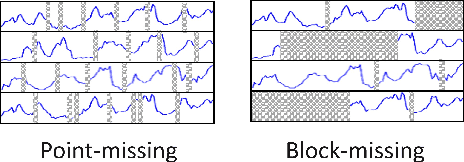
Abstract:Spatiotemporal data mining plays an important role in air quality monitoring, crowd flow modeling, and climate forecasting. However, the originally collected spatiotemporal data in real-world scenarios is usually incomplete due to sensor failures or transmission loss. Spatiotemporal imputation aims to fill the missing values according to the observed values and the underlying spatiotemporal dependence of them. The previous dominant models impute missing values autoregressively and suffer from the problem of error accumulation. As emerging powerful generative models, the diffusion probabilistic models can be adopted to impute missing values conditioned by observations and avoid inferring missing values from inaccurate historical imputation. However, the construction and utilization of conditional information are inevitable challenges when applying diffusion models to spatiotemporal imputation. To address above issues, we propose a conditional diffusion framework for spatiotemporal imputation with enhanced prior modeling, named PriSTI. Our proposed framework provides a conditional feature extraction module first to extract the coarse yet effective spatiotemporal dependencies from conditional information as the global context prior. Then, a noise estimation module transforms random noise to realistic values, with the spatiotemporal attention weights calculated by the conditional feature, as well as the consideration of geographic relationships. PriSTI outperforms existing imputation methods in various missing patterns of different real-world spatiotemporal data, and effectively handles scenarios such as high missing rates and sensor failure. The implementation code is available at https://github.com/LMZZML/PriSTI.
Conditional Diffusion Based on Discrete Graph Structures for Molecular Graph Generation
Jan 01, 2023



Abstract:Learning the underlying distribution of molecular graphs and generating high-fidelity samples is a fundamental research problem in drug discovery and material science. However, accurately modeling distribution and rapidly generating novel molecular graphs remain crucial and challenging goals. To accomplish these goals, we propose a novel Conditional Diffusion model based on discrete Graph Structures (CDGS) for molecular graph generation. Specifically, we construct a forward graph diffusion process on both graph structures and inherent features through stochastic differential equations (SDE) and derive discrete graph structures as the condition for reverse generative processes. We present a specialized hybrid graph noise prediction model that extracts the global context and the local node-edge dependency from intermediate graph states. We further utilize ordinary differential equation (ODE) solvers for efficient graph sampling, based on the semi-linear structure of the probability flow ODE. Experiments on diverse datasets validate the effectiveness of our framework. Particularly, the proposed method still generates high-quality molecular graphs in a limited number of steps.
 Add to Chrome
Add to Chrome Add to Firefox
Add to Firefox Add to Edge
Add to Edge